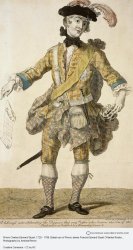© ericdentinger.com
2008-2025
Eric Maclewis - BAGPIPE SOUNDS
Eric Maclewis
Highland Laddie, Highland Lassie
(Robert Burns)
The Lawland Lads think they are fine
But oh they’re vain and idle gaudy
How much unlike the graceful mein
And manly looks o’ my Highland Laddie
If I were free at will to choose
To be the wealthiest Lawland Lady
I’d tak’ young Donald without trews
Wi’ bonnet blue and Highland plaidie
Oh my bonnie bonnie Highland Laddie
Oh my bonnie bonnie Highland Laddie
When I was sick and like to die
He rowed me in his Highland plaidie
O’er Bently Hill wi’ him I’ll run
And leave my Lawland kin and daddy
Frae winters chill and summers sun
He’ll screen me in his Highland plaidie
A painted room, a silken bed
Maun please a Lawland Lord and Lady
But I could kiss and be as glad
Behind a bush in his Highland plaidie
Nae greater joy I’ll ever pretend
Than that his love prove true and steady
Like mine to him, which ne'er shall end
While heaven preserves my Highland Laddie
Oh my bonnie bonnie Highland Laddie
Oh my bonnie bonnie Highland Laddie
When I was sick and like to die
He rowed me in his Highland plaidie
Highland Dancing
Listen on the album (1st tune)
HIGHLAND LADDIE
MARCH
- score by Eric Maclewis with CelticPipes
Highland Laddie, the young man from the Highlands, is based on a melody from the Scottish repertoire, If Thou'lt Play Me Fair Play.
Several lyrics have been attached to this tune, especially those of Robert Burns, describing a difficult love between a young man from the Highlands in a kilt and a young girl (lassie) from the Lowlands.
In 1881, this air was imposed as a Quick March for all British Highland regiments.
It is still the main march of many regiments in the United Kingdom, Canada, etc...
Traditionally presented in two parts, several variations have nevertheless been written (up to eight parts in total).
The tune is also used for a Scottish Highland Dancing of the same name, one of the few kilt dances.











